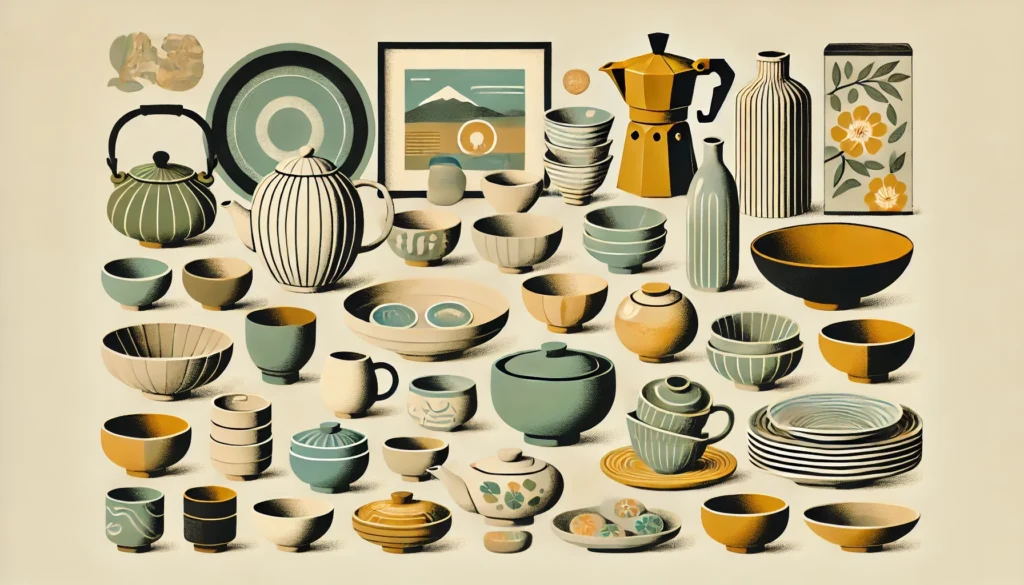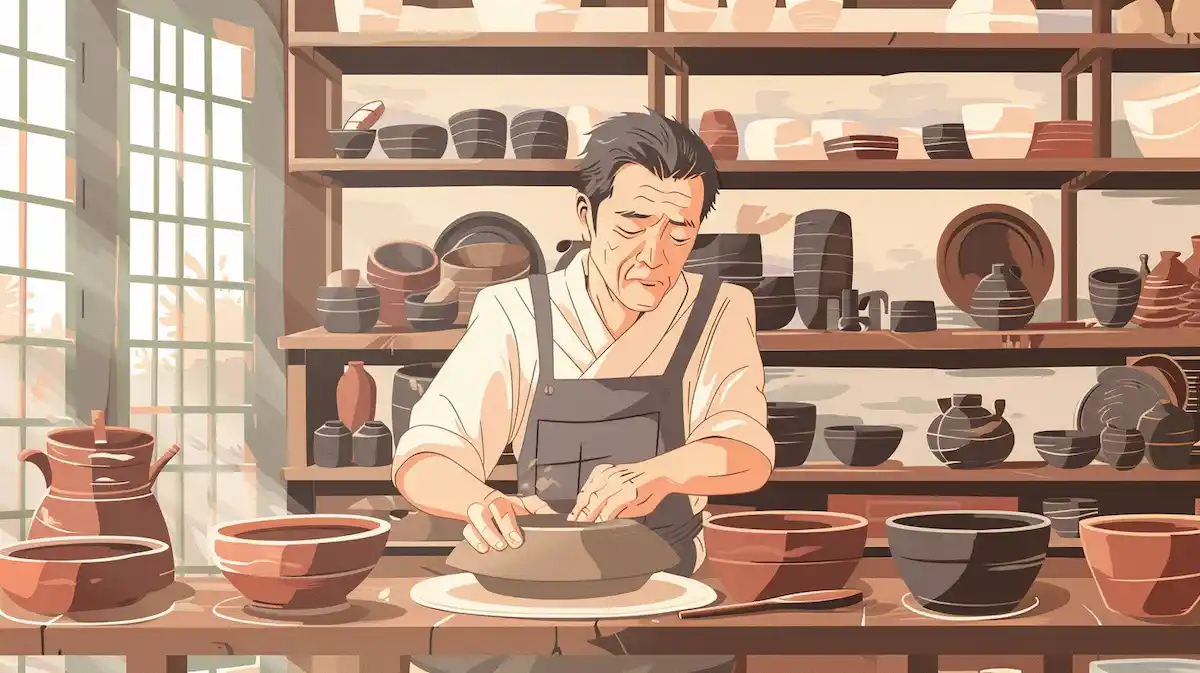美濃焼を英語で説明・紹介するための基本情報と、英会話に役立つ表現をシンプルでわかりやすい英語で紹介します。
英会話ダイアローグ・関連情報・10の質問を通して、美濃焼に関する英語表現を学びます。
英語
英会話ダイアローグを読む前に知っておくと良い前提知識と情報です。
- 美濃焼の基本:
- 岐阜県美濃地方で作られる伝統的な陶器、1300年以上の歴史がある
- 多様なスタイルがあり、代表的なものに志野焼や織部焼がある
- 志野焼と織部焼:
- 志野焼:白い柔らかい釉薬が特徴で、落ち着いた優雅な雰囲気を持つ
- 織部焼:緑色の銅釉薬を使い、大胆で斬新なデザインが特徴
- 茶道との関係:
- 美濃焼は特に茶道具として重宝され、茶の湯文化と深い関わりがある
- 侘び寂び(わびさび)という美学に通じるシンプルで不完全な美しさが評価されている
- 現代の人気:
- 美濃焼は今でも日本国内外で人気がある日常使いの食器やインテリアアイテムとしても広く使用
2人が美濃焼について話しています。
美濃焼の歴史、志野焼と織部焼の特徴、茶道との関係、実用性や人気、陶芸体験などを話題にしています。
会話 / dialogue

Hey Key, I’ve been really interested in Mino ware lately. I want to learn more about it. Do you know much about it?

Yeah, Mino ware is pretty famous! It’s one of Japan’s oldest types of pottery, with over 1,300 years of history. What got you interested in it?

I recently saw some beautiful pieces at a local pottery shop. The designs were so varied, and the shopkeeper mentioned styles like Shino and Oribe. I want to know more about those styles.

Ah, Shino and Oribe are two of the most famous Mino ware styles. Shino ware is known for its soft, milky white glaze, which gives it a calm and elegant look. Oribe ware, on the other hand, is bold, with green copper glaze and creative, often asymmetrical designs.

I love how each piece has such a different feel. I’ve heard that Mino ware has a strong connection to tea ceremonies. Is that true?

Absolutely. During the Azuchi-Momoyama period, Mino ware became really popular for tea ceremony utensils. Tea masters like Furuta Oribe played a big role in its development. Oribe ware, in fact, is named after him. The designs reflect the “wabi-sabi” philosophy, embracing simplicity and imperfection.

That’s fascinating! I’ve always been drawn to the idea of “wabi-sabi.” So Mino ware wasn’t just for decoration but had practical uses too?

Exactly! Mino ware is not only beautiful but also very practical. That’s one reason it’s still popular today, even for everyday dishes. The pieces are strong, and they come in a variety of shapes and sizes for different uses.

I noticed that. Some of the plates and bowls I saw seemed perfect for daily meals. Why is Mino ware still so popular today, though? It has such a long history, yet people still love it.

It’s the balance of tradition and innovation. Mino ware has deep roots in history, but artisans continue to innovate with new designs and techniques. Plus, it’s widely available, so people can find pieces that fit their taste and budget.

That makes sense. I’ve also heard Mino ware is popular overseas. Is that true?

Yes, especially with the growing interest in Japanese food culture. Many restaurants outside Japan use Mino ware because it complements the aesthetic of Japanese cuisine so well. The craftsmanship and quality are admired globally.

I’d love to visit Gifu someday and see where it’s made. Maybe even try making a piece myself. Have you ever been there?

I haven’t been to the workshops, but I know the Mino region, especially Toki City, is famous for its pottery. You can even take pottery-making classes there. It would be a great experience for someone as interested in Mino ware as you are!

That sounds amazing! I’ll definitely look into that. By the way, do you have a favorite Mino ware style?

I’m a fan of Oribe ware. I love its bold and creative designs. How about you? Do you have a preference?

I think I’m leaning toward Shino ware. There’s something calming about its soft white glaze. It feels timeless.

That’s a great choice. Shino ware has a really peaceful, understated beauty. It’s perfect for tea ceremonies or just adding a touch of elegance to everyday life.

Definitely. I’m excited to learn more and maybe start a small collection. Thanks for sharing all this with me!

Anytime! Let me know when you plan to visit Gifu. Maybe we can go together and explore the world of Mino ware more deeply.

Sounds like a plan! I can’t wait.
関連情報 / related information
「美濃焼」について、理解を深めるための「英語での関連情報」です。
美濃焼

History of Mino Ware
Mino ware is a traditional Japanese pottery that has been made for over 1,300 years. It started in the Mino region, which is now part of Gifu Prefecture. The pottery became especially popular during the Azuchi-Momoyama period (1568–1600), when tea ceremonies were an important part of Japanese culture. Mino ware was used for making tea bowls and other items for the tea ceremony.
Famous Styles
There are many styles of Mino ware, but two of the most famous are Shino and Oribe. Shino ware is known for its soft, milky white glaze, which gives it a calm and simple look. Oribe ware is different, with its bold designs and green copper glaze. Both styles are still popular today and are used in tea ceremonies and for everyday dishes.
Popularity and Practicality
Mino ware is not only beautiful but also practical. The pottery is strong and durable, making it perfect for daily use. People love Mino ware because it offers many styles and designs to suit different tastes. It is also popular outside Japan, especially in restaurants that serve Japanese cuisine, where it complements the food perfectly.
10の質問 / 10 questions
「美濃焼」について、理解を深めるための「英語での10の質問」です。
1: What is Mino ware?
Mino ware is a traditional Japanese pottery made in the Mino region, now Gifu Prefecture. It has been produced for over 1,300 years and is known for its variety of styles and practical uses.
2: What are some famous styles of Mino ware?
Two of the most famous styles are Shino ware and Oribe ware. Shino ware has a soft white glaze, while Oribe ware is known for its bold designs and green copper glaze.
3: When did Mino ware become popular?
Mino ware became especially popular during the Azuchi-Momoyama period (1568–1600), when it was used for tea ceremonies and tea utensils.
4: What makes Shino ware unique?
Shino ware is unique for its soft, milky white glaze that gives it a calm and elegant appearance, making it popular in tea ceremonies.
5: How is Oribe ware different from other styles?
Oribe ware stands out because of its bold, creative designs and its use of a distinctive green copper glaze. It often features asymmetrical patterns.
6: What is the connection between Mino ware and tea ceremonies?
Mino ware has a strong connection to tea ceremonies. It was widely used to create tea bowls and other utensils, and its designs reflect the wabi-sabi aesthetic of simplicity and imperfection.
7: Why is Mino ware still popular today?
Mino ware is popular today because of its combination of beauty and practicality. Its strong and durable design makes it perfect for everyday use, while its traditional styles are admired worldwide.
8: Where is Mino ware made?
Mino ware is primarily made in the Mino region, which is in modern-day Gifu Prefecture, especially in areas like Toki City.
9: Can you make Mino ware yourself?
Yes, there are pottery workshops in the Mino region where visitors can try making Mino ware. It’s a great way to experience the traditional craftsmanship.
10: Is Mino ware popular outside Japan?
Yes, Mino ware is appreciated worldwide, especially in restaurants that serve Japanese cuisine. Its beauty and quality are admired globally.

和訳付
会話 / dialogue

Hey Key, I’ve been really interested in Mino ware lately. I want to learn more about it. Do you know much about it?
ねえキー、最近美濃焼にすごく興味があるんだ。もっと知りたいんだけど、何か詳しいこと知ってる?

Yeah, Mino ware is pretty famous! It’s one of Japan’s oldest types of pottery, with over 1,300 years of history. What got you interested in it?
うん、美濃焼はかなり有名だよ!日本で最も古い陶器の一つで、1300年以上の歴史があるんだ。何で興味を持ったの?

I recently saw some beautiful pieces at a local pottery shop. The designs were so varied, and the shopkeeper mentioned styles like Shino and Oribe. I want to know more about those styles.
近所の陶器店で美しい作品を見かけたんだ。デザインがすごく多様で、店主が志野焼や織部焼のことを教えてくれたんだけど、もっと知りたくなったんだ。

Ah, Shino and Oribe are two of the most famous Mino ware styles. Shino ware is known for its soft, milky white glaze, which gives it a calm and elegant look. Oribe ware, on the other hand, is bold, with green copper glaze and creative, often asymmetrical designs.
志野焼と織部焼は美濃焼の中でも特に有名なスタイルだよ。志野焼は柔らかいミルク色の釉薬で落ち着いて優雅な印象があるんだ。一方、織部焼は緑の銅釉薬と、斬新で非対称なデザインが特徴的なんだ。

I love how each piece has such a different feel. I’ve heard that Mino ware has a strong connection to tea ceremonies. Is that true?
それぞれの作品が全然違う雰囲気を持っているのがすごくいいよね。美濃焼は茶道と深い関わりがあるって聞いたんだけど、本当?

Absolutely. During the Azuchi-Momoyama period, Mino ware became really popular for tea ceremony utensils. Tea masters like Furuta Oribe played a big role in its development. Oribe ware, in fact, is named after him. The designs reflect the “wabi-sabi” philosophy, embracing simplicity and imperfection.
そうだよ。安土桃山時代に美濃焼は茶道具として大人気になったんだ。古田織部みたいな茶人がその発展に大きく貢献したんだよ。織部焼は彼にちなんで名付けられたんだ。デザインは、侘び寂びの思想を反映していて、シンプルさや不完全さを大切にしているんだ。

That’s fascinating! I’ve always been drawn to the idea of “wabi-sabi.” So Mino ware wasn’t just for decoration but had practical uses too?
それはすごく面白いね!「侘び寂び」の考え方にはずっと引かれてたんだ。じゃあ、美濃焼は飾るだけじゃなくて、実用的だったんだね?

Exactly! Mino ware is not only beautiful but also very practical. That’s one reason it’s still popular today, even for everyday dishes. The pieces are strong, and they come in a variety of shapes and sizes for different uses.
その通り!美濃焼は美しいだけじゃなく、実用的なんだ。だからこそ、今日でも日常の食器として人気があるんだよ。丈夫で、形やサイズもいろいろだから、用途に応じて使えるんだ。

I noticed that. Some of the plates and bowls I saw seemed perfect for daily meals. Why is Mino ware still so popular today, though? It has such a long history, yet people still love it.
それは気づいたよ。見たお皿やボウルは、日常の食事にぴったりだと思った。だけど、どうして美濃焼は今でもそんなに人気なんだろう?歴史がすごく長いのに、みんなに愛され続けているよね。

It’s the balance of tradition and innovation. Mino ware has deep roots in history, but artisans continue to innovate with new designs and techniques. Plus, it’s widely available, so people can find pieces that fit their taste and budget.
それは、伝統と革新のバランスだね。美濃焼には深い歴史があるけど、職人たちは常に新しいデザインや技術を取り入れて革新しているんだ。それに、幅広く流通しているから、自分の好みや予算に合った作品を見つけやすいんだよ。

That makes sense. I’ve also heard Mino ware is popular overseas. Is that true?
それで納得したよ。美濃焼が海外でも人気があるって聞いたんだけど、本当?

Yes, especially with the growing interest in Japanese food culture. Many restaurants outside Japan use Mino ware because it complements the aesthetic of Japanese cuisine so well. The craftsmanship and quality are admired globally.
うん、特に日本の食文化への関心が高まってるからね。海外のレストランでも、美濃焼は日本料理の美しさを引き立てるからよく使われてるんだ。職人技と品質は世界的に評価されているよ。

I’d love to visit Gifu someday and see where it’s made. Maybe even try making a piece myself. Have you ever been there?
いつか岐阜に行って、美濃焼が作られている場所を見てみたいな。自分で作ってみるのもいいかも。キーは行ったことある?

I haven’t been to the workshops, but I know the Mino region, especially Toki City, is famous for its pottery. You can even take pottery-making classes there. It would be a great experience for someone as interested in Mino ware as you are!
工房には行ったことないけど、美濃地域、特に土岐市は陶器で有名だよ。そこでは陶芸教室もあるし、美濃焼に興味があるマックにはぴったりの体験になると思うよ!

That sounds amazing! I’ll definitely look into that. By the way, do you have a favorite Mino ware style?
それはすごいね!絶対に調べてみるよ。ところで、キーのお気に入りの美濃焼のスタイルってある?

I’m a fan of Oribe ware. I love its bold and creative designs. How about you? Do you have a preference?
わたしは織部焼が好きだな。大胆で創造的なデザインがすごく魅力的だよ。マックはどう?好きなスタイルはある?

I think I’m leaning toward Shino ware. There’s something calming about its soft white glaze. It feels timeless.
僕は志野焼に惹かれてるかな。あの柔らかい白い釉薬が落ち着くし、時代を超えた感じがするんだ。

That’s a great choice. Shino ware has a really peaceful, understated beauty. It’s perfect for tea ceremonies or just adding a touch of elegance to everyday life.
それはいい選択だね。志野焼は本当に穏やかで控えめな美しさがあるよ。茶道にもぴったりだし、日常生活に少しエレガンスを加えるのにもいいよね。

Definitely. I’m excited to learn more and maybe start a small collection. Thanks for sharing all this with me!
そうだね。もっと学んで、ちょっとしたコレクションを始めるのも楽しみだよ。いろいろ教えてくれてありがとう!

Anytime! Let me know when you plan to visit Gifu. Maybe we can go together and explore the world of Mino ware more deeply.
いつでも!岐阜に行く計画ができたら教えてよ。もしかしたら一緒に行って、美濃焼の世界をもっと深く探求できるかもね。

Sounds like a plan! I can’t wait.
いいね!今から楽しみだよ。
関連情報 / related information
美濃焼

History of Mino Ware
Mino ware is a traditional Japanese pottery that has been made for over 1,300 years. It started in the Mino region, which is now part of Gifu Prefecture. The pottery became especially popular during the Azuchi-Momoyama period (1568–1600), when tea ceremonies were an important part of Japanese culture. Mino ware was used for making tea bowls and other items for the tea ceremony.
美濃焼は1300年以上の歴史を持つ日本の伝統的な陶器です。美濃地方(現在の岐阜県)で始まりました。特に、茶道が日本文化の重要な一部であった安土桃山時代(1568年~1600年)に美濃焼は大きな人気を得ました。美濃焼は茶碗や茶道具を作るために使用されました。
Famous Styles
There are many styles of Mino ware, but two of the most famous are Shino and Oribe. Shino ware is known for its soft, milky white glaze, which gives it a calm and simple look. Oribe ware is different, with its bold designs and green copper glaze. Both styles are still popular today and are used in tea ceremonies and for everyday dishes.
美濃焼にはさまざまなスタイルがありますが、特に有名なものに志野焼と織部焼があります。志野焼は、柔らかくミルク色の釉薬で、落ち着いたシンプルな見た目が特徴です。織部焼はそれとは異なり、大胆なデザインと緑色の銅釉薬が特徴です。どちらのスタイルも現在でも人気があり、茶道や日常の食器として使われています。
Popularity and Practicality
Mino ware is not only beautiful but also practical. The pottery is strong and durable, making it perfect for daily use. People love Mino ware because it offers many styles and designs to suit different tastes. It is also popular outside Japan, especially in restaurants that serve Japanese cuisine, where it complements the food perfectly.
美濃焼は美しいだけでなく、実用的でもあります。この陶器は丈夫で長持ちするため、日常使いにぴったりです。多くの人々が美濃焼を愛する理由は、さまざまなスタイルやデザインがあり、それぞれの好みに合わせられるからです。また、日本国外でも人気があり、特に日本料理を提供するレストランでは、料理に見事にマッチするため使用されています。
10の質問 / 10 questions
1: What is Mino ware?
美濃焼とは何ですか?
Mino ware is a traditional Japanese pottery made in the Mino region, now Gifu Prefecture. It has been produced for over 1,300 years and is known for its variety of styles and practical uses.
美濃焼は美濃地方(現在の岐阜県)で作られる日本の伝統的な陶器です。1300年以上の歴史があり、多様なスタイルと実用性で知られています。
2: What are some famous styles of Mino ware?
美濃焼の有名なスタイルは何ですか?
Two of the most famous styles are Shino ware and Oribe ware. Shino ware has a soft white glaze, while Oribe ware is known for its bold designs and green copper glaze.
有名なスタイルには志野焼と織部焼があります。志野焼は柔らかい白い釉薬が特徴で、織部焼は大胆なデザインと緑の銅釉薬で知られています。
3: When did Mino ware become popular?
美濃焼が人気になったのはいつですか?
Mino ware became especially popular during the Azuchi-Momoyama period (1568–1600), when it was used for tea ceremonies and tea utensils.
美濃焼は安土桃山時代(1568年~1600年)に特に人気を集め、茶道や茶道具に使用されました。
4: What makes Shino ware unique?
志野焼の特徴は何ですか?
Shino ware is unique for its soft, milky white glaze that gives it a calm and elegant appearance, making it popular in tea ceremonies.
志野焼は、柔らかくミルク色の釉薬が特徴で、落ち着いた優雅な見た目が茶道で人気を集めています。
5: How is Oribe ware different from other styles?
織部焼は他のスタイルとどう違いますか?
Oribe ware stands out because of its bold, creative designs and its use of a distinctive green copper glaze. It often features asymmetrical patterns.
織部焼は、斬新で大胆なデザインと特徴的な緑の銅釉薬が際立っており、非対称の模様がよく使われます。
6: What is the connection between Mino ware and tea ceremonies?
美濃焼と茶道にはどんな関係がありますか?
Mino ware has a strong connection to tea ceremonies. It was widely used to create tea bowls and other utensils, and its designs reflect the wabi-sabi aesthetic of simplicity and imperfection.
美濃焼は茶道と深い関係があり、茶碗や他の道具に広く使われました。そのデザインは、侘び寂びのシンプルさと不完全さを反映しています。
7: Why is Mino ware still popular today?
美濃焼が今日でも人気の理由は何ですか?
Mino ware is popular today because of its combination of beauty and practicality. Its strong and durable design makes it perfect for everyday use, while its traditional styles are admired worldwide.
美濃焼は、美しさと実用性の両方を兼ね備えているため、今日でも人気があります。丈夫で耐久性があり、日常使いに最適で、伝統的なスタイルが世界中で評価されています。
8: Where is Mino ware made?
美濃焼はどこで作られていますか?
Mino ware is primarily made in the Mino region, which is in modern-day Gifu Prefecture, especially in areas like Toki City.
美濃焼は主に美濃地方(現代の岐阜県)で作られており、特に土岐市などが有名です。
9: Can you make Mino ware yourself?
美濃焼を自分で作ることはできますか?
Yes, there are pottery workshops in the Mino region where visitors can try making Mino ware. It’s a great way to experience the traditional craftsmanship.
はい、美濃地方には、美濃焼作りを体験できる陶芸教室があります。伝統的な職人技を体験する素晴らしい機会です。
10: Is Mino ware popular outside Japan?
美濃焼は日本国外でも人気がありますか?
Yes, Mino ware is appreciated worldwide, especially in restaurants that serve Japanese cuisine. Its beauty and quality are admired globally.
はい、美濃焼は世界中で評価されており、特に日本料理を提供するレストランで人気があります。その美しさと品質は世界的に評価されています。

words & phrases
英会話ダイアローグと関連情報に出てきた単語・フレーズです(例文は各3つ)。

pottery : 名詞
意味: 陶器。Clay objects that are shaped and then fired to make them hard, used for making dishes, bowls, and other items.
(美濃焼のような陶器全般を指す)
例文:
- She collects pottery from different countries.
「彼女は各国の陶器を集めています。」 - The pottery class is held every weekend.
「陶芸教室は毎週末に開催されます。」 - Ancient pottery can tell us a lot about past cultures.
「古代の陶器は過去の文化について多くを教えてくれます。」
glaze : 名詞
意味: 釉薬。A thin, glassy coating applied to pottery before it is fired, giving it a shiny or smooth surface.
(美濃焼の表面に施された釉薬のことを指す)
例文:
- The vase has a beautiful blue glaze.
「その花瓶は美しい青い釉薬がかかっています。」 - She added a sweet glaze to the cake.
「彼女はケーキに甘いグレーズを加えました。」 - After firing, the pot was covered in a shiny glaze.
「焼成後、その壺は光沢のある釉薬で覆われました。」
asymmetrical : 形容詞
意味: 非対称の。Having two sides or parts that are not the same in shape or size.
(織部焼などの美濃焼の非対称なデザインを指す)
例文:
- The artist designed an asymmetrical sculpture.
「そのアーティストは非対称の彫刻をデザインしました。」 - The asymmetrical pattern on the plate makes it unique.
「その皿の非対称な模様がユニークさを引き立てています。」 - Her haircut is asymmetrical, longer on one side.
「彼女の髪型は非対称で、一方が長くなっています。」
imperfection : 名詞
意味: 不完全。A flaw or defect in something that prevents it from being perfect.
(美濃焼の「侘び寂び」美学の中で、完璧ではないことを肯定する意味で使用)
例文:
- The vase had a small imperfection, but it added character.
「その花瓶には小さな欠点があったが、それが味わいを増していた。」 - Her face was beautiful despite its imperfections.
「彼女の顔は、不完全さがあっても美しかった。」 - The imperfection in the painting made it more interesting.
「その絵の不完全さが、より興味深いものにしていた。」
craftsmanship : 名詞
意味: 職人技。The skill or quality of a person who is very skilled in making things by hand.
(美濃焼を作る職人たちの技術や手作業の素晴らしさを指す)
例文:
- The craftsmanship of the handmade bowl is amazing.
「その手作りのボウルの職人技は驚くべきものです。」 - You can see the fine craftsmanship in every detail of the cabinet.
「そのキャビネットのすべての細部に細やかな職人技が見られます。」 - His attention to detail shows his excellent craftsmanship.
「彼の細部へのこだわりが、彼の優れた職人技を物語っています。」
